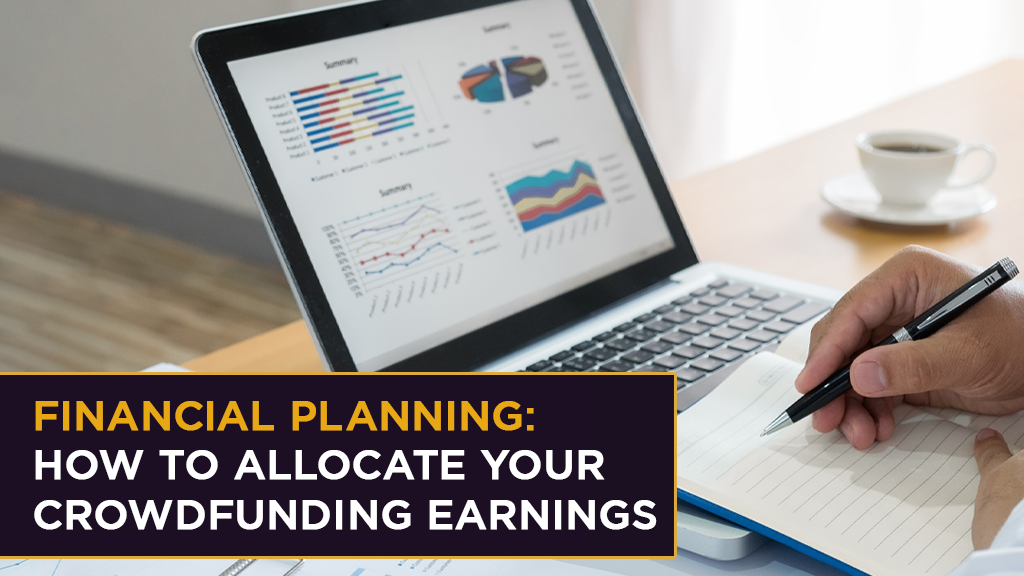
There’s a lot that goes into setting your funding goal for your crowdfunding campaign. Once you hit that goal, it’s a wonderful feeling of accomplishment — but the question of how best to allocate your crowdfunding earnings will inevitably sink in.
If you enter the post-campaign phase without a solid financial plan, you could be setting yourself up for some major problems. The worst situation to be in is getting to a place where you aren’t able to fulfill the orders of all of your backers.
You don’t have to be an expert in financial planning, but a little bit of knowledge about how best to spend your money after a campaign can go a long way. Let’s first look at some basic principles of financial planning, as well as how they can be used in a crowdfunding campaign.
Contents
- What is financial planning and how can it be used in a successful crowdfunding campaign?
- Has my crowdfunding campaign been successful?
- How to create a financial plan for your earnings
- Step 1: Make an analysis of your spending
- Step 2: Pay what needs to be paid
- Step 3: Seek out professionals and learn with them
- Step 4: Invest in benchmarking
- Step 5: Expand your portfolio
- Final thoughts on allocating your crowdfunding earnings
- Financial planning: how to allocate your crowdfunding earnings: Frequently Asked Questions
What is financial planning and how can it be used in a successful crowdfunding campaign?
To start, what is financial planning? At its core financial planning is about having a goal, and then assessing your resources and creating a strategy to achieve that goal. Part of any financial planning strategy may include things like budgeting, saving, investing, and managing debt. No matter if it’s an individual, business, or organization, financial planning is essential for being able to make informed decisions about spending.
So why is financial planning important and how does it apply to crowdfunding? In the context of crowdfunding earnings, there are several reasons why good financial planning plays an important role.
- Setting realistic funding goals: Good financial planning in crowdfunding actually starts before you raise a single dollar. Knowing how to calculate the right funding goal for your product is the first step before you can accomplish the rest.
- Budgeting: Budgeting is just as important before a campaign as it is once you’ve reached your funding goal. Knowing your budget will help you allocate the right amount of funds for things like advertising, platform fees, and other expenses.
- Cash flow management: Having a strong grasp of cash flow is crucial in crowdfunding because receiving your funds is not an immediate process. There will be plenty of expenses that require payment but not a steady cash flow, so it’s important to allocate resources accordingly.
- Risk management: Financial planning also involves identifying and mitigating risks associated with the campaign. This could include factors such as unexpected expenses, changes in market conditions, or delays in production. By anticipating potential risks, organizers can develop contingency plans to address them if they arise.
Overall, financial planning touches on multiple aspects of the crowdfunding process. The ability to carefully track expenses and strategically allocate spending will make fulfillment much easier, which in turn can result in long-term success for your brand.
Has my crowdfunding campaign been successful?
On the subject of long-term success, we always encourage creators to adopt this mindset when setting out to launch a product through crowdfunding. If there’s one thing LaunchBoom has learned since launching our first campaign in 2015, it’s that short-term success in large crowdfunding campaigns does not equal long-term business success.
Simply put: Large crowdfunding campaigns can be a nightmare for financial planning. It may sound counterintuitive, but it’s very difficult to have a profitable campaign that also raises over one million dollars.
The first major challenge of any campaign is not having enough margins — even when reaching a funding goal. Managing a large campaign raise may look like a huge financial gain, but getting to these kinds of raises also costs a lot of money. Here are some of the possible costs associated with a campaign that gets subtracted from your final raise:
- 10 percent paid to the crowdfunding platform
- 10 percent paid to a crowdfunding agency (if you worked with one)
- A small percentage lost from discounts offered to backers
- Setup costs for things like a campaign video, graphic design, PR, etc.
That’s a lot of money gone right off the bat, and that doesn’t even take ad spend into account. Margins are very tight, and many of these expenses scale up the higher your raise. Without careful financial planning, it’s easy to end up becoming unprofitable.

Unless you have extra cash set aside, no gross profit means no money left to actually make the product you’re crowdfunding for. A good example of this is when it happened to the Coolest Cooler campaign, which raised $13 million but still needed to continue to sell on Amazon to keep operations running.
What do you consider to check the success of your crowdfunding campaign?
So what makes a successful campaign, and how do you measure it? Unfortunately, the answer isn’t as straightforward as you think.
The answer comes down to more than just one number. It would be nice to be able to say “You need to raise $X in your campaign to be successful,” but that’s not the case for everyone. Instead, here are the things we recommend all creators to measure in order to determine crowdfunding success:
1) You achieve these goals:
- You acquire customers profitably and validate you have a market.
- You pay for your first manufacturing run.
- You ship your product on time (or close to on time).
2) You understand and financial plan for these key aspects of your business:
- Business metrics:
- Cost to produce your product
- Cost to ship your product
- Cost to acquire a customer
- 3) You understand your customer:
- Which audiences are most likely to buy your product
- Which product messaging resonates the most with those audiences
- Which customer acquisition channels are most effective
Accomplishing the goals you set out for yourself and using these core metrics as a roadmap won’t come automatically. Knowing what to aim for is crucial, but being able to create a sound financial plan is the true secret behind achieving long-term business success.
How to create a financial plan for your earnings
Math isn’t everybody’s strong suit, but trust us when we say: It’s a foundational element to crowdfunding success.
Creating a good financial plan isn’t easy and it takes time, and that’s where some creators might feel too overwhelmed to try. If this is you, we understand. Hopefully, we can dispel some of the fears you might have in tackling this task, as well as provide a clear breakdown of how to create a financial plan for your crowdfunding earnings and illustrate why financial planning is important.
Step 1: Make an analysis of your spending
When your campaign comes to a close, it is very important to have a clear understanding of everything you’ve spent in the lead-up to your final raise.
Throughout your campaign, you will have done a lot of spending. From ad spend to platform payments, to all of the costs associated with setting up your campaign page, there’s a lot that goes into hitting your funding goal.
You won’t be able to avoid spending more than you thought sometimes, but the mantra to live by is “spend money to make money, not lose money.” You want to get as high a return on investment (ROI) as you possibly can. How do you know if your return will be positive? By making a thorough analysis of your spending.
Let’s break down some of the key business metrics mentioned earlier that will account for much of your spending.
Cost to produce your product
Before you even start your crowdfunding campaign, it’s advisable to start getting quotes from different potential shipping partners to give you an idea of how much it will cost to produce your product.
There are two metrics you want to identify: cost per unit and minimum order quantity.
- Cost per unit: This metric is how much money you will spend on the production of a single unit. Consider all componentry and build material when determining the final cost per unit. One seemingly mundane decision for something like the weight of a single component can result in extra costs that can add up very quickly.
- Minimum order quantity: This is the smallest number of products that you must purchase in a single order from a supplier. Different suppliers set different rates, so find the deal that makes the most sense for you.
If you can find out your cost per unit and minimum order quantity, this effectively tells you how much you need to make to have a successful campaign. This figure doesn’t have to be your funding goal, but it is key in building your overall financial plan.
Cost to ship your product
When calculating this metric, it’s important to understand that shipping costs don’t just boil down to the cost to get from a fulfillment center to the backer. You’re going to encounter ancillary costs like how much it costs to move the product out of the factory, or how many shipping containers will you need to get it to your fulfillment center.
Shipping breaks down into two parts: the first mile and the last mile. The first mile accounts for moving the product from the factory to the fulfillment center, and it’s common to encounter hidden fees and extra costs due to product weight. The last mile is the cost to ship from the fulfillment center to backers.
Overall, logistics is a very tricky subject. Extra and unnecessary costs incurred here can negatively impact the price point of your product. Be sure to find a shipping partner you are comfortable with — and one who makes it a priority to help save you money.
Cost to acquire a customer
If you’re familiar with LaunchBoom’s pre-launch reservation strategy, you know that backers won’t just flock to your page out of thin air. You’re going to have to spend some money to earn those funds through a well-crafted marketing strategy.
Don’t lose sight of how much you spend in this category; as it’s been mentioned, every dime adds up. If you’re conservative with your pre-campaign estimates and do your best not to overspend with poor ROI, you will have a much easier time paying off everything after finally receiving your funds.
Step 2: Pay what needs to be paid
Another important thing to account for when planning for your major influx of cash after your campaign is what debts need to be paid first. Fulfilling financial obligations, like taxes, fees, and repayments related to your campaign is important for avoiding further financial penalties.
Don’t be tempted to kick too many important payments down the road. The goal is absolutely to use your funding to start taking care of manufacturing and fulfillment, which would have been accounted for if you set your funding goal correctly. Much of your extra funds raised can then go into paying incurred business debts.
Let’s look at some of the reasons why you should always pay what needs to be paid.
- You can avoid interest, penalties, and stress: Unpaid debts often come with interest — and that accrues over time. Clearing debts as quickly as possible will save you a lot of money and stress over the long run.
- You maintain legal compliance: By using crowdfunding platforms like Kickstarter and Indiegogo, you enter into legal contracts with them stipulating you will pay the necessary fees involved once your campaign has finished. Forgetting to do so — or avoiding doing so altogether — is a good way to set yourself up for problems in the future.
- You preserve your brand’s reputation: Part of paying what needs to be paid goes hand in hand with supporting long-term financial goals. Clearing debts and paying for the right things to get your products to your backers in a timely manner will go towards building a positive relationship with them.
Step 3: Seek out professionals and learn with them
We appreciate that many crowdfunding creators have a DIY attitude, but financial planning is something that people without accounting or business experience should feel no shame in seeking professional help for. Not everybody knows how to write a financial plan.
If you’ve been working with crowdfunding consultants for the duration of your campaign, they are a good resource to rely on for sound financial planning. And while LaunchBoom has been through a fair share of successful campaigns, every creator and business is different. When it comes to finances, it’s always best to seek out the experts.
Financial advisors have specialized knowledge and expertise, and they can help you manage your funds raised through crowdfunding down to the penny. Not only that, they are accustomed to thinking about the long-term financial stability and growth of your company. Finding the right financial advisor may be another expense, but it has the potential to pay off significantly.
Step 4: Invest in benchmarking
Benchmarking in business and finance involves comparing your business’ performance, processes, and practices against similar competitors in the same industry. The goal is to identify areas where your business can improve, as well as learn from the successes of others. This kind of comparative analysis can also be done after your crowdfunding campaign, and can very much be worth making part of your financial plan.
Here are some of the strategic advantages of benchmarking:
- Performance evaluation: Benchmarking lets you assess your own financial performance against crowdfunding peers. Some of the best financial metrics to look out for are revenue growth, profit margins, and their own ROIs. Knowing how others did can paint a picture of how you might be able to improve upon their results.
- Setting better goals and targets: Knowing what success looks like for other creators can help establish achievable targets for you to aim for. This can help you focus your resources on those areas that led to success for them.
- More informed decision-making: Benchmarking can also provide good insights into areas like product development, market expansion, and investment allocation. Understanding how competitors used their finances in these areas can help you and your financial team make more informed decision-making specific to your product, campaign size, and industry.
Step 5: Expand your portfolio
Diversifying investments is a powerful strategy in any financial plan since it helps to reduce risk and increase returns. This can involve various asset allocations like stocks, bonds, real estate, and alternative investments.
While it is good to have a diversified portfolio with your own money, we don’t recommend being too liberal with investments using backer funds. The last thing you want to do is risk losing any of your backers’ money.
Instead, invest in the important things: paying off outstanding debts, fulfilling your orders, and growing your business to make the transition to e-commerce.
Final thoughts on allocating your crowdfunding earnings
If you’re successful in your crowdfunding raise, nothing will feel more precious than the funds you get from your backers. After all, it’s what you set out for when you decided to embark on this journey.

Using that money correctly might feel like a major responsibility — one that you feel you might mess up if you don’t make the right decisions. For that reason, it’s strongly recommended that you make a financial plan for allocating your crowdfunding earnings. Not only will it help you make better decisions, it will make every step of the post-campaign process that much more seamless.
Don’t worry if you’re still unsure of what to do, though. LaunchBoom is here to help. If you’d like to discuss the best steps to take in creating a sound financial plan, hit the “talk to an expert” button below or sign up for our newsletter for up-to-date educational content. No matter where you are on your crowdfunding journey, we’re here to lend our expertise.
Financial planning: how to allocate your crowdfunding earnings: Frequently Asked Questions
Why is financial planning important?
Financial planning is a vital part of any business endeavor. However, it is especially important for crowdfunding because of the unpredictable financial factors. Knowing how much you need for your first round of production, as well as what it will take to ship those orders, helps you plan for all of the variability.
Is a budget a tool for financial planning?
Budgets are essential tools for financial planning and help greatly with income management, expense tracking, and creating spending discipline.
How much does a financial plan cost?
Professionally made financial plans can vary in price depending on several factors, including the complexity of the plan, the scope of the services, and the experience of the person making the plan. Consider that some will charge a flat fee, while some charge by the hour. Choose a financial planner whose cost structure makes the most sense for your budget.
Are financial planning fees for crowdfunding tax deductible?
Fortunately, financial planning fees for your business can be tax deductible. To make sure you take full advantage of any deductions, consult a tax professional or account for the best advice.




